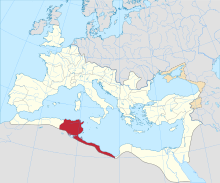
Carthage was the capital city of ancient Carthage, on the eastern side of the Lake of Tunis in what is now Tunisia. Carthage was one of the most important trading hubs of the Ancient Mediterranean and one of the most affluent cities of the classical world.
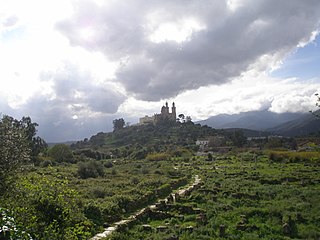
Hippo Regius is the ancient name of the modern city of Annaba, Algeria. It historically served as an important city for the Phoenicians, Berbers, Romans, and Vandals. Hippo was the capital city of the Vandal Kingdom from 435 to 439 AD. until it was shifted to Carthage following the Vandal capture of Carthage (439).
Parthenia was a Roman–Berber town in the former Roman province of Mauretania Sitifensis, the easternmost part of ancient Mauretania. It was located in what is now northern Algeria.
In ancient Greece, the term ecumene (U.S.) or oecumene denoted the known, inhabited, or habitable world. In Greek antiquity, it referred to the portions of the world known to Hellenic geographers, subdivided into three continents: Africa, Europe, and Asia. Under the Roman Empire, it came to refer to civilization itself, as well as the secular and religious imperial administration.

Utica was an ancient Phoenician and Carthaginian city located near the outflow of the Medjerda River into the Mediterranean, between Carthage in the south and Hippo Diarrhytus in the north. It is traditionally considered to be the first colony to have been founded by the Phoenicians in North Africa. After Carthage's loss to Rome in the Punic Wars, Utica was an important Roman colony for seven centuries.
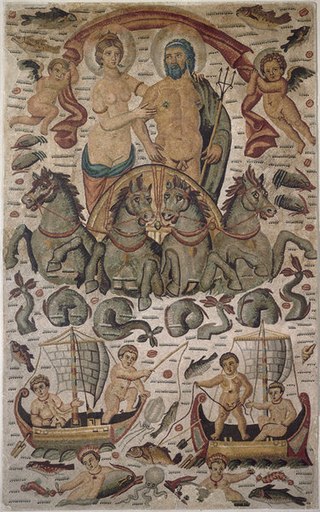
Cirta, also known by various other names in antiquity, was the ancient Berber and Roman settlement which later became Constantine, Algeria.

Gafsa is the capital of Gafsa Governorate of Tunisia. With a population of 111,170, Gafsa is the ninth-largest Tunisian city and it is 335 kilometers from the capital Tunis.
Kelibia (Kélibia), often referred to as Klibia or Gallipia by European writers, is a coastal town on the Cap Bon peninsula, Nabeul Governorate in the far north-eastern part of Tunisia. Its sand beaches are considered some of the finest in the Mediterranean.
Apamea Myrlea was an ancient city and bishopric on the Sea of Marmara, in Bithynia, Anatolia; its ruins are a few kilometers south of Mudanya, Bursa Province in the Marmara Region of Asian Turkey.

Khamissa, ancient Thubursicum Numidarum or Thubursicum, is an Ancient Roman and Byzantine archeological site, in Souk Ahras Province of northeastern Algeria.

Christianity is a minority religion in Libya. It has been present in Tripolitania and Cyrenaica since Roman times.
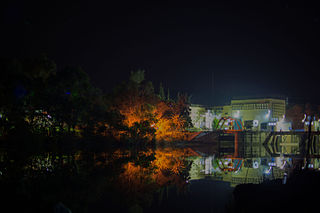
Tebourba is a town in Tunisia, located about 20 miles (30 km) from the capital Tunis, former ancient city and bishopric, now a Latin Catholic titular see.
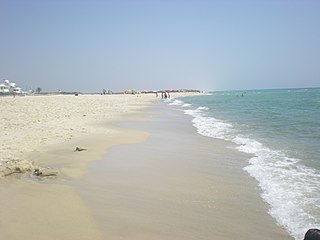
Korba, ancient Curubis, is a town in Tunisia on the eastern shore of the Cap Bon. It was the place of exile of the Carthaginian bishop Cyprian in the year leading up to his martyrdom. Modern Korba is in the Nabeul Governorate and had a population of 48,314 in 2014.

Téboursouk is a town and commune in the Béja Governorate, Tunisia. It is located at 36° 27′ 26″N, 009° 14′ 54″E.

Tinja or Tindja (تينجة) is a town and commune (municipality) in the Bizerte Governorate, in northern Tunisia, on the shores of Lake Ichkeul. Its name derives from that of the ancient Roman era city of Thimida, a former bishopric which remains a Latin Catholic titular see.

Pupput, also spelled "Putput", "Pudput", "Pulpud" and "Pulpite" in Latin, sometimes located in Souk el-Obiod ou Souk el-Abiod, is a Colonia in the Roman province of Africa which has been equated with an archaeological site in modern Tunisia. It is situated on the coast near the town of Hammamet, between the two wadis of Temad to the north and Moussa to the south. Much of the Pupput is buried under modern holiday developments which have been built over the major part of the site.

The Vandal Kingdom or Kingdom of the Vandals and Alans was a confederation of Vandals and Alans, which is one of the barbarian kingdoms established under Gaiseric, a Vandal warrior. It ruled in North Africa and the Mediterranean from 435 to 534 AD.

Calama was a colonia in the Roman province of Numidia situated where Guelma in Algeria now stands.

Cartennae or Cartenna was an ancient, Carthaginian, and Roman port at present-day Ténès, Algeria. Under the Romans, it was part of the province of Mauretania Caesariensis.
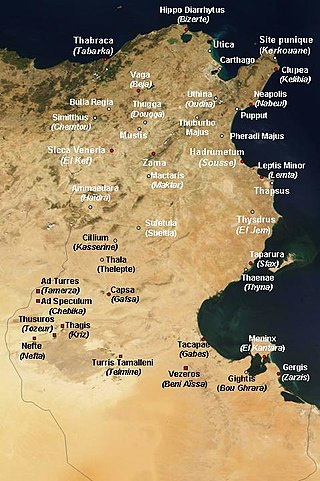
Turris Tamalleni was a town in North Africa, dating from the Carthageinian, Roman, Byzantine and Vandal era.
